Contextualism emphasizes the importance of context in interpreting meaning, arguing that understanding a statement depends on the surrounding circumstances and background knowledge. This approach challenges fixed interpretations by highlighting how language and truth can vary with different contexts. Discover how contextualism reshapes perception and enhances your grasp of communication in the full article.
Table of Comparison
| Aspect | Contextualism | Formalism |
|---|---|---|
| Definition | Interprets art based on cultural, historical, and social contexts. | Analyzes art strictly through its form, structure, and visual elements. |
| Focus | Meaning derived from context surrounding the artwork. | Intrinsic features such as color, line, shape, and composition. |
| Key Entities | Artist's background, cultural influences, historical period. | Art elements, design principles, visual harmony. |
| Purpose | Understanding significance and message within context. | Appreciating aesthetic value and formal qualities. |
| Example | Analyzing Picasso's Guernica as a political statement. | Evaluating Mondrian's Composition based on geometric balance. |
Understanding Contextualism: An Overview
Contextualism emphasizes interpreting texts, laws, or events by considering the surrounding circumstances, social norms, and historical background to derive meaning. This approach contrasts with formalism by prioritizing context over strict textual analysis, enabling a flexible understanding aligned with evolving societal conditions. Key applications of contextualism appear in legal theory, literary criticism, and philosophy, where meaning shifts depend on situational factors and speaker intent.
Defining Formalism in Literary and Art Criticism
Formalism in literary and art criticism emphasizes analyzing the intrinsic features of a work, such as structure, style, and form, rather than external contexts like author intent or historical background. This approach prioritizes elements like narrative techniques, imagery, symbolism, and compositional balance to interpret meaning and aesthetic value. Formalism treats the artwork as a self-contained entity, where understanding is derived from its internal relationships and formal properties.
Historical Origins of Contextualism and Formalism
Contextualism emerged in the early 20th century as a reaction to rigid legal formalism, emphasizing the importance of social, economic, and historical contexts in interpreting laws. Formalism, rooted in 19th-century legal positivism, advocates for a strict, literal application of legal texts regardless of external factors. The divergence between these philosophies reflects foundational debates on judicial interpretation and the role of courts in adapting laws to evolving societal conditions.
Key Philosophical Differences Between Contextualism and Formalism
Contextualism argues that the meaning of legal texts depends on the specific context, including historical background, social factors, and the purpose of the law, emphasizing flexibility and practical outcomes. Formalism, by contrast, insists on a strict adherence to the literal text and established legal rules, advocating for consistency, predictability, and neutrality in judicial interpretation. Key philosophical differences between the two include contextualism's focus on the evolving social context versus formalism's focus on objective, rule-based reasoning independent of external influences.
Major Proponents: Influential Thinkers in Both Camps
Contextualism is championed by thinkers like Ronald Dworkin, who emphasize the importance of social, historical, and moral contexts in legal interpretation. Formalism finds strong advocates in figures such as Justice Antonin Scalia, who argue for strict adherence to legal texts and structural rules, minimizing external influences. These influential proponents shape ongoing debates by defending contrasting methodologies that reflect divergent views on judicial decision-making and the nature of law.
Contextualism in Practice: Real-World Applications
Contextualism in practice emphasizes interpreting laws and texts by considering social, historical, and cultural contexts, enabling more adaptive and relevant applications across diverse legal systems and disciplines. This approach is widely used in constitutional law, where judges assess the framers' intentions and societal values to resolve contemporary issues. Contextualism also informs contract interpretation, ensuring that agreements reflect the parties' actual circumstances and intentions rather than rigid formal rules.
Formalism in Practice: Examples and Case Studies
Formalism in practice emphasizes strict adherence to legal texts and established statutes, prioritizing the literal meaning of words over external factors. Key examples include the U.S. Supreme Court case *Farmers & Merchants Bank v. Federal Reserve*, where judges relied solely on statutory language without considering broader social implications. Case studies such as Justice Scalia's opinions showcase formalism by interpreting constitutional provisions with a focus on original text and intent, highlighting the approach's consistency and predictability in judicial decision-making.
Criticisms and Limitations of Contextualism
Contextualism faces criticism for its potential subjectivity, as interpretation heavily relies on varying contexts, which may lead to inconsistent legal outcomes. Critics argue that this approach can undermine the predictability and uniformity of law, complicating judicial decision-making. Furthermore, contextualism may allow excessive judicial discretion, risking bias and reducing the stability of legal systems.
Criticisms and Limitations of Formalism
Formalism often faces criticism for its rigidity and failure to account for the complexities of language and cultural context, leading to interpretations that can be overly literal or disconnected from real-world meaning. Critics argue that formalist approaches disregard the importance of historical background, author intent, and reader experience, which are essential for a comprehensive understanding of texts. This limitation restricts formalism's applicability in diverse interpretative scenarios, especially in legal and literary analysis where context significantly shapes meaning.
Bridging the Gap: Contemporary Debates and Future Directions
Contextualism and Formalism represent two dominant approaches in legal theory, with debates increasingly focusing on bridging their divide by integrating context-sensitive interpretation with structured legal frameworks. Contemporary discussions emphasize the potential for hybrid models that balance the rigidity of formal rules with the flexibility required to address evolving societal values and complex real-world scenarios. Future directions aim to develop adaptive jurisprudence methods that leverage both contextual insights and formal principles to enhance judicial decision-making accuracy and legitimacy.
Contextualism Infographic

 libterm.com
libterm.com